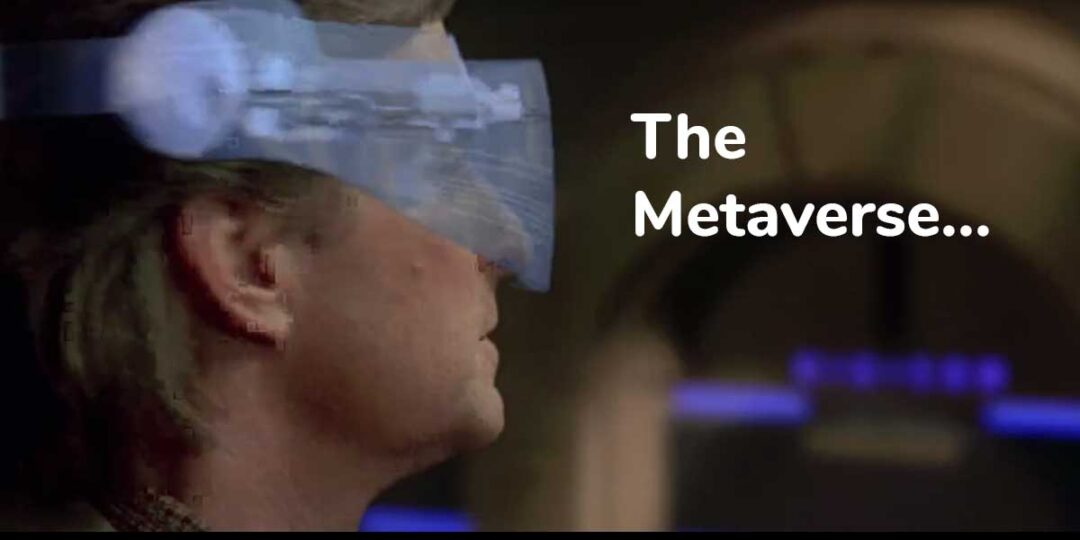History of the Metaverse and why it’s nothing new…
The Metaverse Imagined
The word Metaverse was first used thirty years ago by one of my favourite authors – Neal Stephenson, in a 1992 book, Snow Crash, though the concept predates that. (Think of Star-Trek’s Holodeck circa 1974). Stephenson imagined a world where human interaction would be a mixture of analogue and digital – meaning that a person could interact with an avatar representation of another human, or maybe the avatar of an artificial intelligence in the physical and digital world.
There have been a lot of versions of the metaverse imagined and depicted in film and TV. The 1982 film Tron tells the story of a computer programmer who is transported inside the software world of a mainframe computer. And in 1994’s Disclosure Michael Douglas enters a VR style database, interacting with an AI called the Angel, trying to stop his enemy’s avatar from deleting incriminating files – which seems prophetic given the ‘Facebook Papers’. Of course there are many others… The Matrix for example.
The Reality of the Metaverse so far…
Facebook (sorry Meta) have a rather simplistic definition of the metaverse:
“The ‘metaverse’ is a set of virtual spaces where you can create and explore with other people who aren’t in the same physical space as you.”
In that sense, versions of a metaverse have been used since the ‘internet’ was invented. Multi-User Dungeons or Dimensions (MUD) were text based spaces where the lack of a virtual-reality headset was filled in by the imagination. Worlds and rooms were described in text as were character descriptions.
As the graphics and technology improved, these experiences allowed ‘players’ to represent themselves through avatars in games like Runescape (launched 2001) or ‘chat rooms’ like Habbo (launched 2000) and IMVU (launched in 2004), but in all these cases, the user interface is / was a computer screen.
The MMorpg (Massively Multiplayer online role-playing game) has become more sophisticated as graphics cards and internet connectivity has increased, but the product is the same – escapism and fantasy. Driven by games like Fortnite and Minecraft, the virtual world is not exactly evolved.
The Dirty Secrets of the Metaverse
Traditionally, virtual worlds have existed so that socially awkward individuals could role-play and escape their lonely, mundane real-world existence through fantasy. Without the gamification element, people aim to satisfy their most basic needs.
For the most part, such virtual worlds are not linked to a real-world ID. So think of the Twitter model rather than Facebook. Imagine if you could magically appear at a party. You could be anything or anyone you wanted. Without looking someone in the eye and without repercussions of ‘failure’ or rejection you could say what you want.
If you don’t believe that – try dropping into an unmoderated chat room and see the level of discourse in any of these worlds. If you really want to learn what drives online spaces, drop in as a female!
In 2005, Yahoo closed all of it’s chat rooms. Some operators had monitors to watch activity on its servers, however efforts to monitor chat for any effect appear to be futile. The straightforward truth of the matter is free, unmediated chat isn’t safe. And now… Facebook, the company that has shown that it can’t moderate content in 2D form is going to promote a more immersive, emotionally engaging version of the online world through the next generation of metaverse.
The metaverse is trans. Yes, if you identify as a bisexual furry futa then these are your people. But in reality, the metaverse is male. Yes there is an increasing number of gamers that are female, but in terms of the socially awkward, isolated, tech-savvy escapists that inhabit online worlds there is an overwhelming number of men.
The Potential of the Metaverse
In 2020, large parts of the world were disrupted by Covid19. The sense of isolation for many was intensified through lock-downs and being forced to work from home. People managed using tools like Zoom to work and do brunch, but it was an unsatisfactory proxy for real-life.
Perhaps the new version of the metaverse could make another pandemic more bearable, but more than likely it is a new kind of tititainment – a way to distract the masses.
Where the metaverse could really come into its own and be a force for good is for people who have limited ability to participate in the ‘real-world’. For people with disabilities, the metaverse could provide a much better life.





No Comments